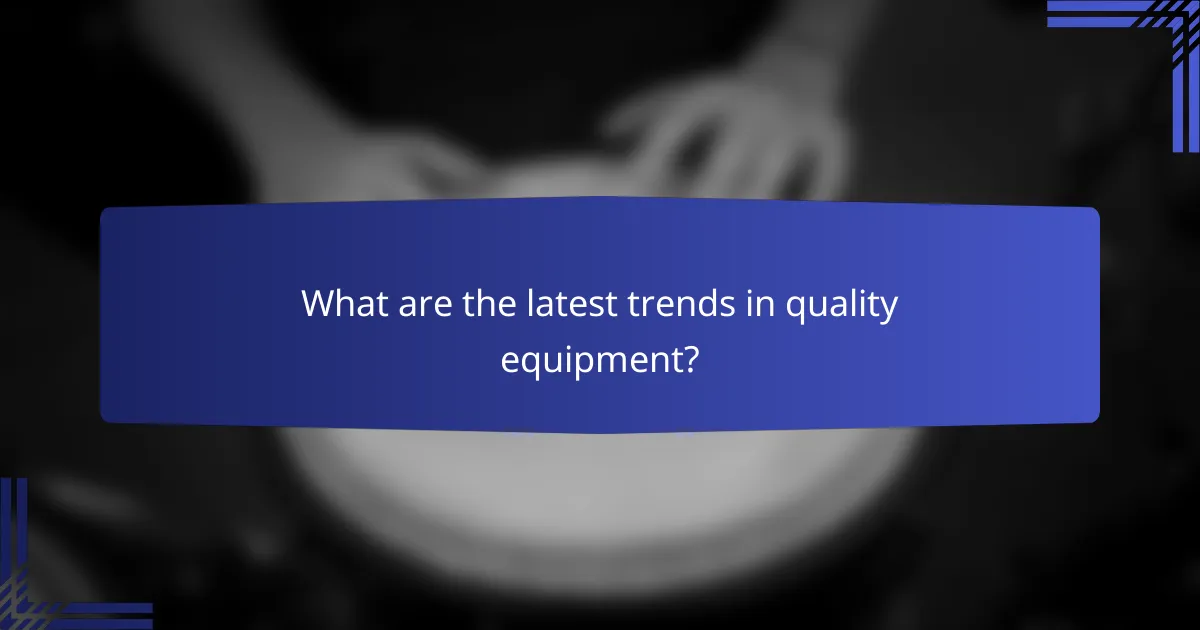Choosing quality equipment is crucial for ensuring optimal performance and longevity, whether for home use or professional settings. By carefully considering your specific needs, budget, and essential features such as durability, ergonomics, and safety certifications, you can make informed decisions that enhance your experience and satisfaction with your purchases.

What are the best quality equipment options for home use?
The best quality equipment options for home use include high-end brands, mid-range alternatives, and budget-friendly choices. Selecting the right equipment depends on your specific needs, frequency of use, and budget constraints.
High-end brands like Bosch and DeWalt
High-end brands such as Bosch and DeWalt are known for their durability and performance. These brands often offer professional-grade tools that can withstand heavy use and provide precision.
Investing in high-end equipment typically means higher upfront costs, often ranging from a few hundred to over a thousand dollars. However, their longevity and reliability can save money in the long run by reducing the need for frequent replacements.
Mid-range options from Ryobi and Black+Decker
Mid-range brands like Ryobi and Black+Decker strike a balance between quality and affordability. These options are suitable for DIY enthusiasts and homeowners who require reliable tools for occasional use.
Prices for mid-range equipment generally fall between $50 and $300. They offer decent performance and features, making them a practical choice for those who do not need professional-grade tools but still want something that lasts.
Budget-friendly choices from Harbor Freight
Budget-friendly options from Harbor Freight provide an economical solution for those on a tight budget. These tools are often priced under $50 and are ideal for light tasks or infrequent use.
While these tools may not offer the same durability as higher-end brands, they can be a good starting point for beginners or those who need tools for occasional projects. It’s essential to assess the quality and warranty options before purchasing to ensure they meet your needs.

How to evaluate equipment quality?
Evaluating equipment quality involves assessing its durability, brand reputation, and the support offered by the manufacturer. These factors collectively determine the reliability and longevity of the equipment, helping you make an informed purchasing decision.
Material durability and construction
Material durability is crucial for ensuring that equipment withstands regular use and environmental factors. Look for products made from high-quality materials such as stainless steel, aluminum, or reinforced plastics, which typically offer better longevity. Pay attention to the construction methods used, as well; welded joints are often stronger than those that are merely glued or bolted.
Consider the intended use of the equipment. For instance, if you need tools for outdoor activities, opt for weather-resistant materials. A good rule of thumb is to check for industry standards or certifications that indicate durability, such as ISO ratings.
Brand reputation and reviews
Brand reputation plays a significant role in evaluating equipment quality. Established brands with a history of reliability often provide better products and customer service. Look for brands that are well-reviewed by users and have a solid track record in your specific equipment category.
Online reviews and ratings can offer insights into the experiences of other customers. Focus on reviews that discuss long-term use and performance, as these will give you a clearer picture of the equipment’s quality over time. Be cautious of brands with consistently negative feedback or unresolved complaints.
Warranty and customer support
A strong warranty is a key indicator of equipment quality, as it reflects the manufacturer’s confidence in their product. Look for warranties that cover a reasonable period, typically ranging from one to several years, and ensure you understand what is included. A longer warranty often suggests better durability and reliability.
Additionally, assess the customer support offered by the manufacturer. Responsive and helpful support can make a significant difference if you encounter issues. Check if they provide multiple contact methods, such as phone, email, or live chat, and read reviews specifically about their customer service experiences.

What essential features should I consider?
When choosing quality equipment, essential features include power and performance specifications, ergonomics and usability, and safety features and certifications. Evaluating these aspects ensures that the equipment meets your needs effectively and safely.
Power and performance specifications
Power and performance specifications determine how well the equipment will perform its intended tasks. Look for metrics such as wattage, horsepower, or RPM, depending on the type of equipment. Higher specifications often indicate better performance but may also lead to increased energy consumption.
Consider the balance between power and efficiency. For instance, a tool with a high wattage may complete tasks faster but could also lead to higher electricity costs. Assess your typical usage to find the right balance between power and cost-effectiveness.
Ergonomics and usability
Ergonomics and usability are crucial for comfort and efficiency during operation. Equipment should be designed to minimize strain and fatigue, allowing for prolonged use without discomfort. Features like adjustable handles, lightweight materials, and intuitive controls enhance usability.
Test equipment whenever possible to ensure it feels comfortable in your hands. Look for models with positive user reviews regarding ergonomics, as this can significantly impact your overall experience and productivity.
Safety features and certifications
Safety features and certifications are vital for protecting users from potential hazards. Look for equipment that includes safety guards, automatic shut-off mechanisms, and non-slip grips. Certifications from recognized organizations, such as CE or UL, indicate compliance with safety standards.
Before purchasing, verify that the equipment meets local safety regulations, as this can vary by region. Investing in well-certified equipment can reduce the risk of accidents and ensure peace of mind during use.

How do I compare costs effectively?
To compare costs effectively, consider both the initial purchase price and the long-term value of the equipment. Analyzing these factors helps you make informed decisions that balance upfront expenses with future savings.
Initial purchase price vs. long-term value
The initial purchase price is the upfront cost you pay for the equipment, while long-term value encompasses the total cost of ownership over its lifespan. When evaluating options, consider not only the price tag but also how the equipment performs, its durability, and potential resale value.
For example, a more expensive piece of equipment may have a longer lifespan and lower operating costs, making it a better investment over time. Aim for equipment that offers a good balance between initial cost and long-term benefits.
Cost of maintenance and repairs
Maintenance and repair costs can significantly impact the total cost of ownership. Regular upkeep is essential to ensure equipment operates efficiently and lasts longer, so factor these expenses into your budget.
Research typical maintenance costs for the equipment you are considering. Some brands may have higher repair costs due to specialized parts or service requirements, which can add up over time. A good rule of thumb is to set aside a percentage of the purchase price annually for maintenance.
Availability of replacement parts
The availability of replacement parts is crucial for minimizing downtime and repair costs. Equipment from well-established brands often has readily available parts, which can save you time and money when repairs are needed.
Before making a purchase, check the manufacturer’s reputation for parts availability and consider the potential wait times for any necessary components. If parts are difficult to find, you may face higher costs and longer repair times, impacting your overall efficiency.

What are the shipping and return policies for quality equipment?
Shipping and return policies for quality equipment vary by retailer but generally include options for free shipping and specific guidelines for returns. Understanding these policies can save you money and ensure a smoother purchasing experience.
Free shipping options from Amazon and Home Depot
Amazon often provides free shipping on orders over a certain amount, typically around $25 for eligible items. Home Depot also offers free shipping on orders over a specific threshold, which can vary based on promotions and product categories.
Both retailers may have membership options, such as Amazon Prime, which can provide additional shipping benefits, including same-day or next-day delivery in select areas. Always check the product page for specific shipping details before purchasing.
Return policies for defective items
Most retailers, including Amazon and Home Depot, allow returns of defective items within a specified period, usually 30 to 90 days from the purchase date. For Amazon, items can often be returned through their online portal, while Home Depot may require you to visit a physical store for assistance.
It’s essential to keep the original packaging and receipt, as these may be required for a full refund or exchange. Check the retailer’s website for detailed instructions on how to initiate a return for defective equipment.
Restocking fees and conditions
Restocking fees can apply when returning certain types of equipment, particularly larger items or those that have been opened. Amazon typically does not charge restocking fees for most items, but Home Depot may impose a fee of around 15% on some returned products.
To avoid restocking fees, ensure that the equipment is returned in its original condition and packaging. Always review the return policy specific to the item you are purchasing to understand any potential fees before making a decision.

What are the latest trends in quality equipment?
Recent trends in quality equipment focus on sustainability, advanced technology integration, and user-centric design. Manufacturers are increasingly prioritizing eco-friendly materials and smart features that enhance usability and efficiency.
Cost Considerations
When selecting quality equipment, cost is a crucial factor. It’s essential to balance upfront expenses with long-term value, including maintenance and operational costs. Investing in higher-quality items may reduce replacement frequency and repair needs, ultimately saving money.
Consider the total cost of ownership (TCO), which includes purchase price, energy consumption, and potential downtime. For example, while a premium machine may cost more initially, its energy efficiency and durability can lead to significant savings over time.
Essential Features
Identifying essential features is vital for effective equipment selection. Look for functionality that meets your specific needs, such as ease of use, safety features, and compatibility with existing systems. Prioritize features that enhance productivity and reduce the risk of errors.
For instance, equipment with intuitive interfaces and automated settings can significantly streamline operations. Additionally, consider features like warranty and support services, which can provide peace of mind and reduce future costs.
